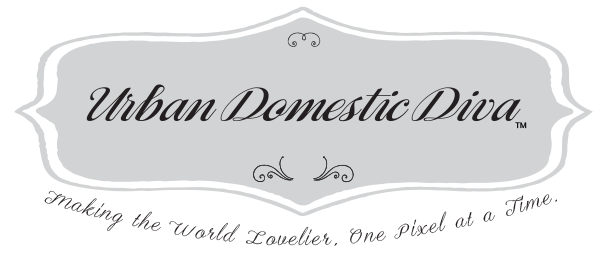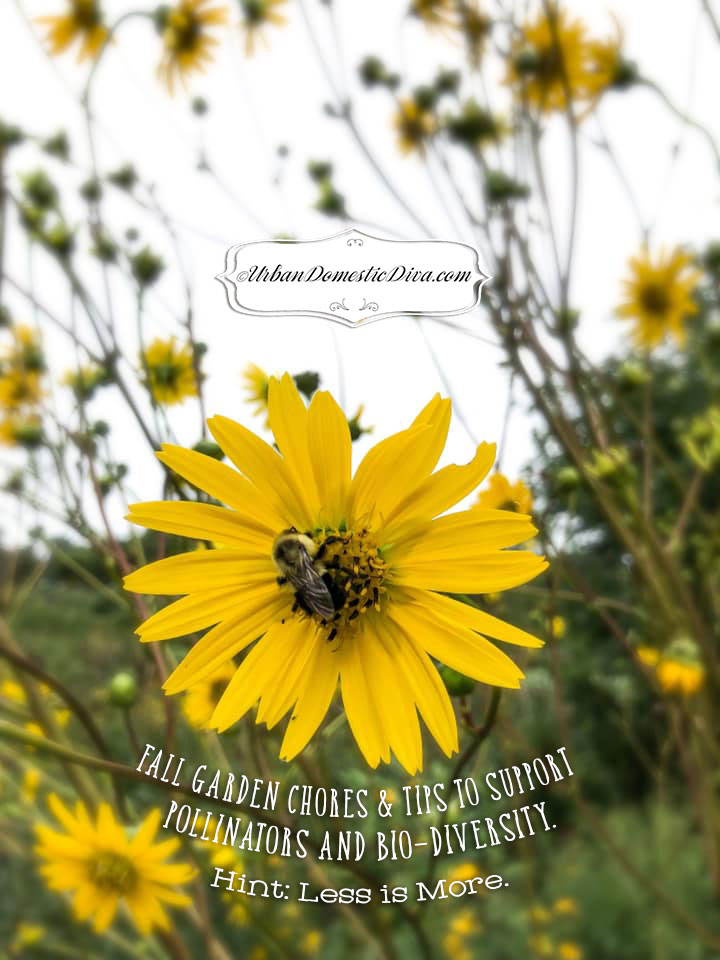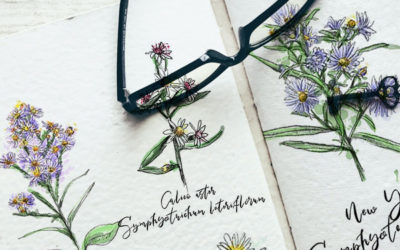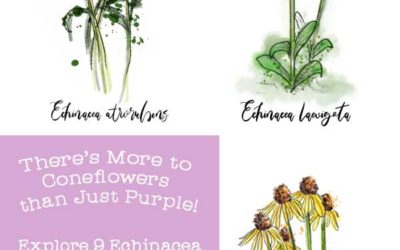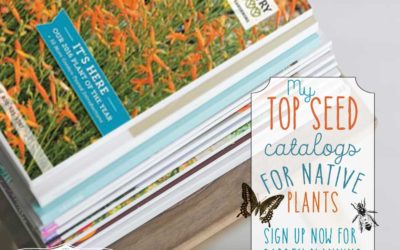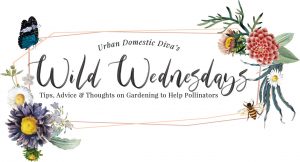
Introducing “Wild Wednesdays!” These posts will be plant features, tips, news, and musings about wildflowers and native plants to support pollinators and bio-diversity. No matter what size garden, everyone can make a difference. Join me every Wednesday, and let’s help save the bees and butterflies.
As we passed the fall equinox, I began a winter to-do list for the garden. I am sure you are doing the same. If you are hoping to nudge your outdoor space into a more pollinator-friendly habitat, I have great news for you! Less is more! Less work. Less tidying. Less everything! Yes, it also means a bit more work come spring, but only a little bit. Even that workload I urge caution and slowness, to assure pollinators are waking up and leaving their nests before you go hog-wild cleaning out beds. But that is another post for next year. Right now, I have a few tips and thoughts regarding fall garden chores and tips to support pollinators and the greater food web in your area.
Leave Leaves.
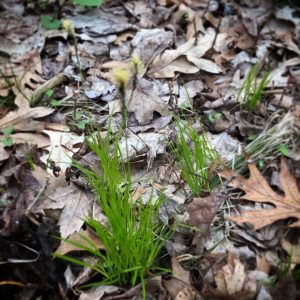 Many people are surprised to hear how many bee species nest in the ground under piles of dead plant matter and debris. Certain species of butterflies and moths also need a blanket of leaves to hibernate through the winter. So rather than bag your raked leaves to go to the garbage, throw them back in your garden beds. Use these piles to keep plants warm, and also create cozy homes for overwintering pollinators, wildlife, and other insects. These leaves will also decompose slowly, richening the soil underneath. Think bout it. This is what happens in nature. Mother Nature isn’t running around the forest with pruning shears, garbage bags, and a rake. Let your garden die back gracefully and naturally. Nature has its own way of cleaning and recycling things. Your habitat will thank you for it. If you have just too many trees-thus leaves-to do this, you can look into pick-up composting services that are popping up in many cities nationwide. Healthy Soil Compost is a great option and partner to my favorite garden center (and friend of the blog) City Grange. You can also use some of your leaves in creating your own compost. We create a few bags of “lazy gardener’s compost” every fall. See below to find out how. But the moral of the story, leave the leaves as much as possible. Less work. More pollinators!
Many people are surprised to hear how many bee species nest in the ground under piles of dead plant matter and debris. Certain species of butterflies and moths also need a blanket of leaves to hibernate through the winter. So rather than bag your raked leaves to go to the garbage, throw them back in your garden beds. Use these piles to keep plants warm, and also create cozy homes for overwintering pollinators, wildlife, and other insects. These leaves will also decompose slowly, richening the soil underneath. Think bout it. This is what happens in nature. Mother Nature isn’t running around the forest with pruning shears, garbage bags, and a rake. Let your garden die back gracefully and naturally. Nature has its own way of cleaning and recycling things. Your habitat will thank you for it. If you have just too many trees-thus leaves-to do this, you can look into pick-up composting services that are popping up in many cities nationwide. Healthy Soil Compost is a great option and partner to my favorite garden center (and friend of the blog) City Grange. You can also use some of your leaves in creating your own compost. We create a few bags of “lazy gardener’s compost” every fall. See below to find out how. But the moral of the story, leave the leaves as much as possible. Less work. More pollinators!
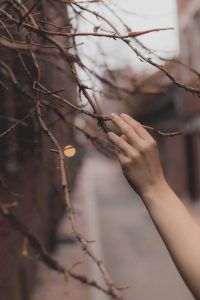
Photo by Dayne Topkin on Unsplash
Prune lightly if you need to, and prune ‘high’.
The other surprising fact is that many bees and other insect pollinators nest in hollowed out stems, woody branches, and canes. Every gardener’s instinct is to tidy up and prune the plants that like being pruned in the fall. I have learned that not many do. But there are some, like oakleaf hydrangea. Any shrub or tree that sets their flower bud in late summer for an early spring bloom has a DO NOT PRUNE sign on them. If you need to prune anything, aim high and leave 10-12” of a stem or branch to leave space for nesting pollinators. Did I just give you permission to pretty much leave most of your shrubs and plants alone to die back naturally? Yes. Pour yourself a pumpkin spice latte and enjoy less work! Will your neighbors think you are being sloppy and lazy leaving a mess in your garden? Maybe. But I urge you to talk to them and let them know what you are doing. The only way to help our local pollinators is to educate our community, one person, at a time.
Leave seed heads to feed wintering birds and animals.
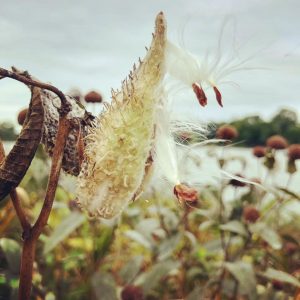 This is another “leave alone” task. Flowers have a natural life cycle, and their cycle is to create seeds and propagate. Fall creates dried up seed heads, ready to drop seeds on the ground or fly on gusts of wind to who knows where. So a couple of things to talk about here. If you have an aggressive native that propagates by seed readily, one way to manage it is to cut the seed heads off before they spread. I would also urge you, however, to collect them, and use them for seed swaps in the spring, versus tossing them away. I also urge you to leave what you can of the dead seed heads that propagate less aggressively, as many birds and small animals use this as a food source during colder weather when food is very scarce. Seed heads also provide homes and protection too, for overwintering insects and pollinators.
This is another “leave alone” task. Flowers have a natural life cycle, and their cycle is to create seeds and propagate. Fall creates dried up seed heads, ready to drop seeds on the ground or fly on gusts of wind to who knows where. So a couple of things to talk about here. If you have an aggressive native that propagates by seed readily, one way to manage it is to cut the seed heads off before they spread. I would also urge you, however, to collect them, and use them for seed swaps in the spring, versus tossing them away. I also urge you to leave what you can of the dead seed heads that propagate less aggressively, as many birds and small animals use this as a food source during colder weather when food is very scarce. Seed heads also provide homes and protection too, for overwintering insects and pollinators.
Harvest some seeds for next year’s plantings and partake in seed swaps come spring.
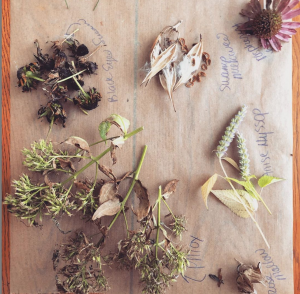 This is a good segway to talk a little bit more about seed harvesting. Yes, I am telling you to leave well enough alone for the most part, but I do urge you to do some seed collecting in the fall. I recently uploaded a youtube video about this. It is very easy, and if there are some plants you have that are difficult to propagate or to find, harvesting 1-2 seed heads for next season is prudent-and economical! Every spring, I am on a budget smaller than my creative vision of my garden goals. Seeds help fill out my beds economically. And I love taking them to seed swaps in April, to exchange what I have a lot of for something I have been meaning to plant. Everybody wins! I always just take enough for what I need, which sometimes is only one seed head. One buttonbush seed head will give you hundreds of seeds. I was able to grow 8 starter plants this year from one buttonbush seed head! A good tip for seed harvesting is freezing the seeds throughout the winter. Then come spring, when you take them out, they think they have gone through a complete season’s cycle and are ready to germinate for you in the warm spring sun.
This is a good segway to talk a little bit more about seed harvesting. Yes, I am telling you to leave well enough alone for the most part, but I do urge you to do some seed collecting in the fall. I recently uploaded a youtube video about this. It is very easy, and if there are some plants you have that are difficult to propagate or to find, harvesting 1-2 seed heads for next season is prudent-and economical! Every spring, I am on a budget smaller than my creative vision of my garden goals. Seeds help fill out my beds economically. And I love taking them to seed swaps in April, to exchange what I have a lot of for something I have been meaning to plant. Everybody wins! I always just take enough for what I need, which sometimes is only one seed head. One buttonbush seed head will give you hundreds of seeds. I was able to grow 8 starter plants this year from one buttonbush seed head! A good tip for seed harvesting is freezing the seeds throughout the winter. Then come spring, when you take them out, they think they have gone through a complete season’s cycle and are ready to germinate for you in the warm spring sun.
Get your garden journal up to date and take photos.

Photo by Daria Shevtsova on Unsplash
I start out every spring so diligently. I have all my beds drawn out. I meticulously notate every move, every new plant. But come August-with school starting, and plant sales, and droughts, and rain, and pests and problems-I pretty much have missed some things, and lost some things, and messed some things up. So take a cup of hot tea one nice fall day and do a garden walk-about. Be really present and look at your space. What worked? What didn’t? What needs moving? What did you plant where? And take photos-lots of photos. What is crisp in your brain now won’t be in the gray-foggy-cold-haze of February. Photos will help you remember what’s what for spring planning.
Create “lazy gardener’s compost” with raked leaves and grass clippings.
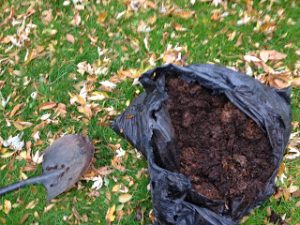 I am going to link you to an older post I wrote about this fantastic approach to compost. Will people think you have dead bodies in garbage bags stored in that sunny corner of your garden all winter? Maybe. But when you pull out that black delicious compost on Memorial Day to mix into your garden beds, you won’t mind the gossip. It is a great way to use up the overflow of mulched leaves and grass clippings that won’t fit on your pots or in your beds.
I am going to link you to an older post I wrote about this fantastic approach to compost. Will people think you have dead bodies in garbage bags stored in that sunny corner of your garden all winter? Maybe. But when you pull out that black delicious compost on Memorial Day to mix into your garden beds, you won’t mind the gossip. It is a great way to use up the overflow of mulched leaves and grass clippings that won’t fit on your pots or in your beds.
Plant any bulbs for spring before the ground freezes.
I always wait too long to plant my spring bulbs, and whatever spring flowers you can grow feeds our just-wakened pollinators. If the bulbs are native plants, even better! Be sure to notate in your journal where you put them, so you don’t accidentally dig them up when they are done as you are putting summer plantings in.
A note on containers…
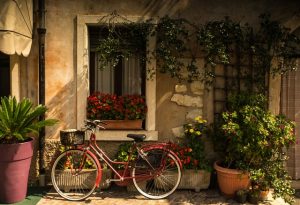
Photo by Jilbert Ebrahimi on Unsplash
If you have been following my classes with City Grange or my books, you know I am a huge advocate in using pots for native plants. I believe they are an often overlooked way to plant natives-even aggressive ones-for gardeners with limited space or growing conditions. Winterizing pots are often a barrier for container gardening. But with easy tips, you can care for your plants-and pollinators-while using containers. For those of you that are trying to create mini habitats in small gardens or on porches and balconies in urban settings, you can care for your native perennials in pots for the winter, which also cares for your local food web. In fact, I especially urge urban dwellers to take part in caring for biodiversity in whatever space they have. It is the only way to stem urban sprawl and habitat loss. This is a huge contributing factor is pollinator numbers declining.
Here Are Some Tips on Winterizing Potted Plants:
- “Heeling in” is a great technique for giving pots insulation during the winter. Either plant the pot in the ground if you have space OR find a larger container, fill it with dirt, mulch, hay, and dead leaves, and set the pot halfway down. Cover the top with extra leaves for good measure.
OR
- After a couple of frosts, bring the plant in a shed, cold frame, basement, or garage. But be sure to water it every once in a while if indoors. The dormant root still needs food and moisture.
OR
- Wrap pots with burlap or group them in a corner and mound hay all around the base, and cover with a blanket.
AND REMEMBER
- Most pollinating bees nest in the ground or in hollowed out stems and tree branches. Butterflies need shelter from rain and some overwinter in the colder zones. So letting plants simply die back and allow dead plant matter to cover your pots or garden will help nesting bees as well as butterflies.
If you wish to learn more about gardening to help support pollinators, check out my bee advocacy page as well as my books.
- Sugar-Free, Low-Carb, Olive Oil Chocolate Hazelnut Tart - February 18, 2023
- Easy Slow Cooker French Onion Soup - November 28, 2022
- Recipe: Chicken Vindaloo with Whole Foods Vindaloo Curry Powder - January 22, 2022
